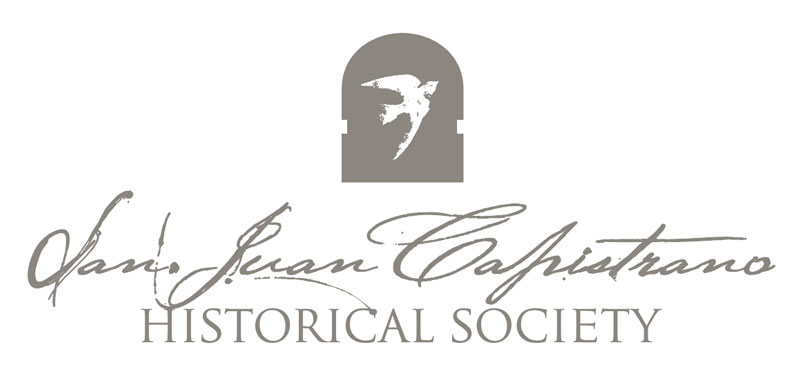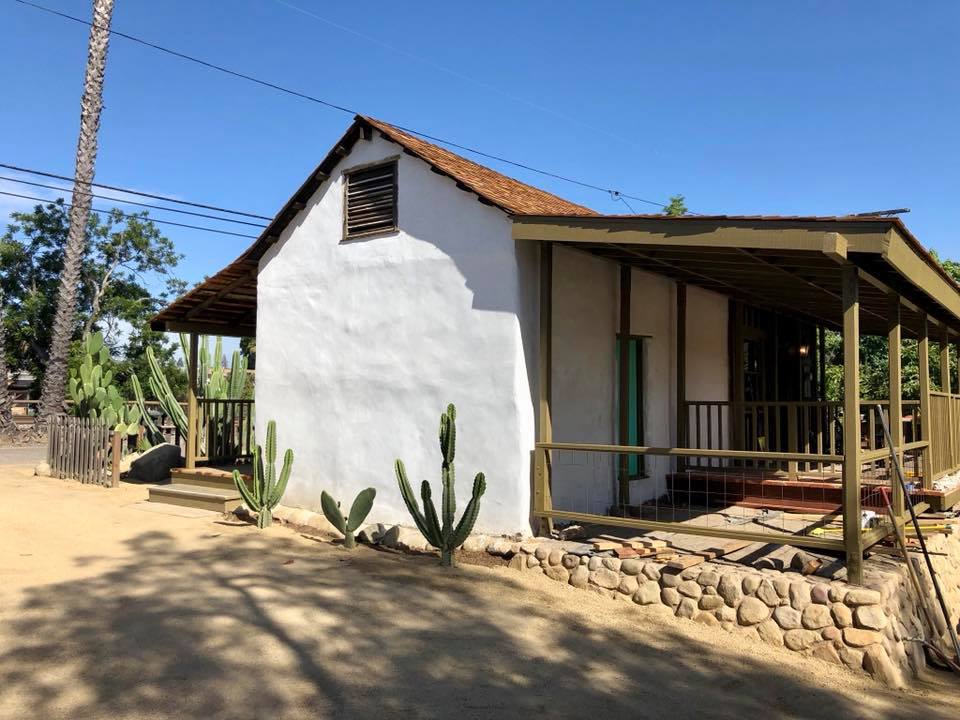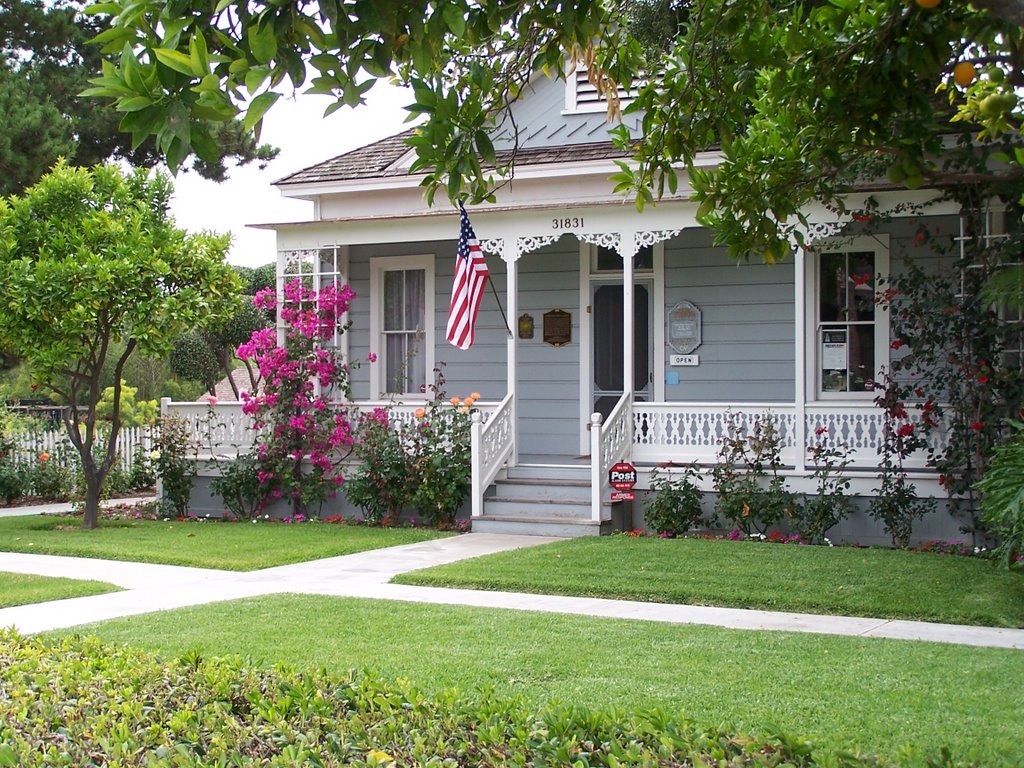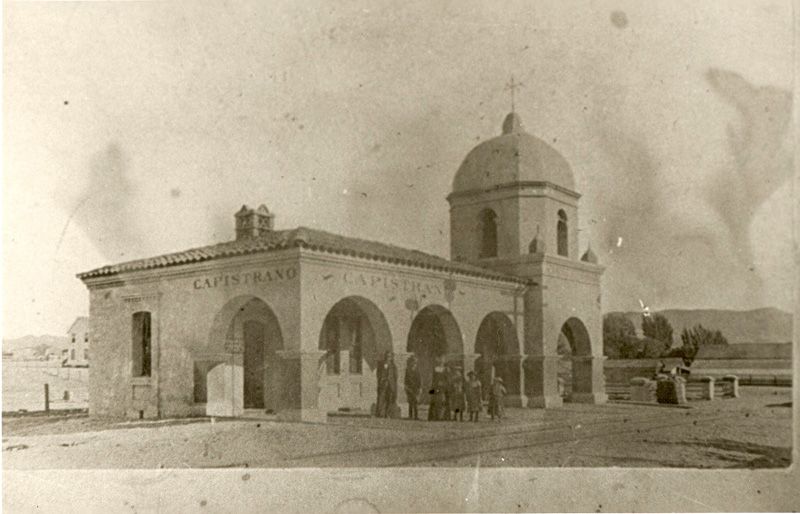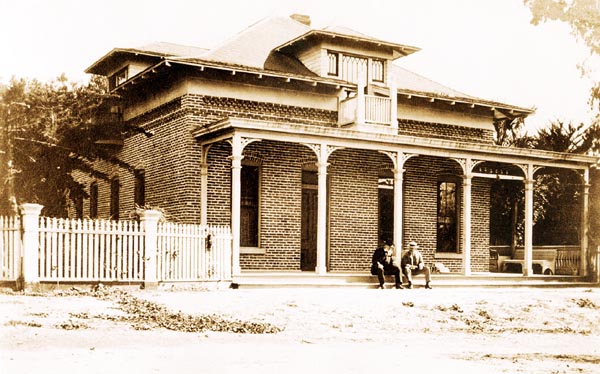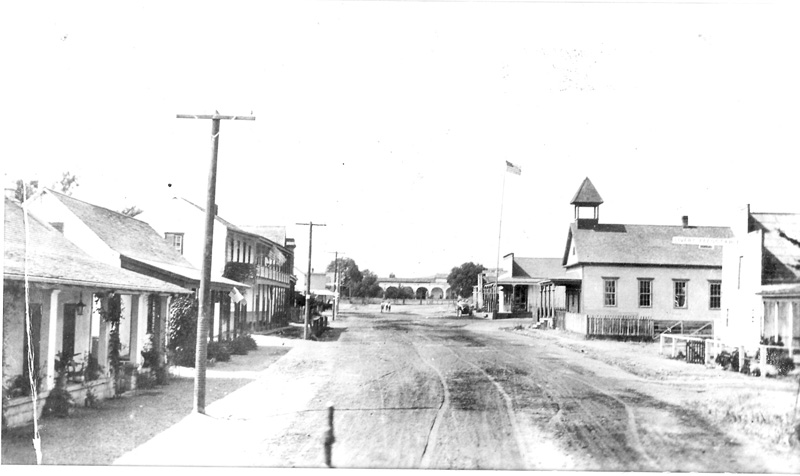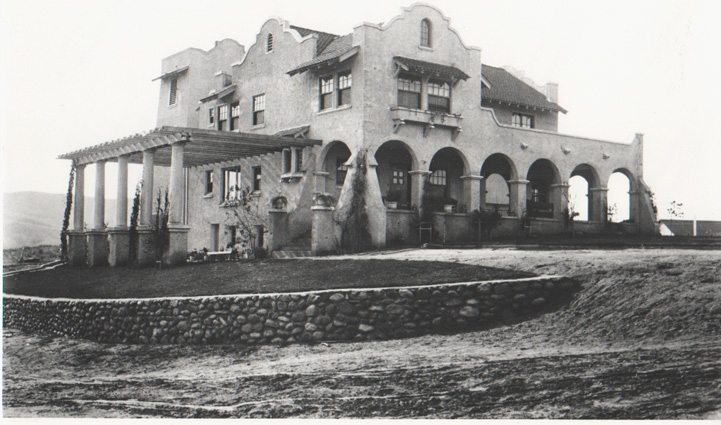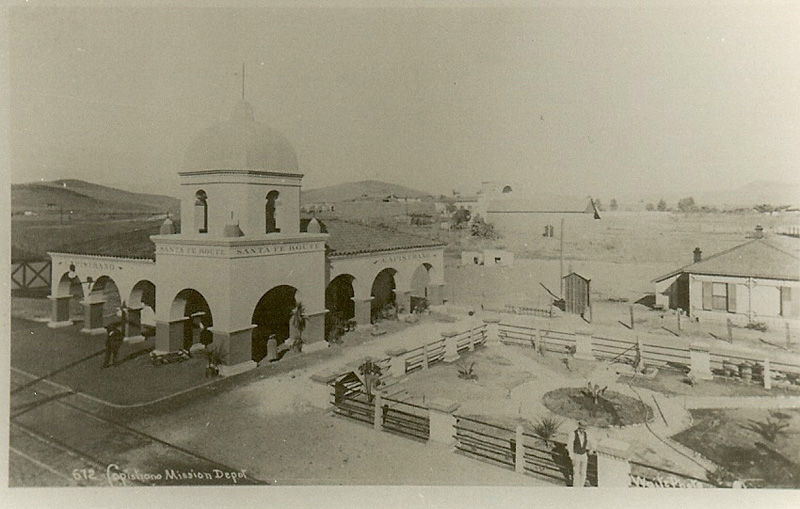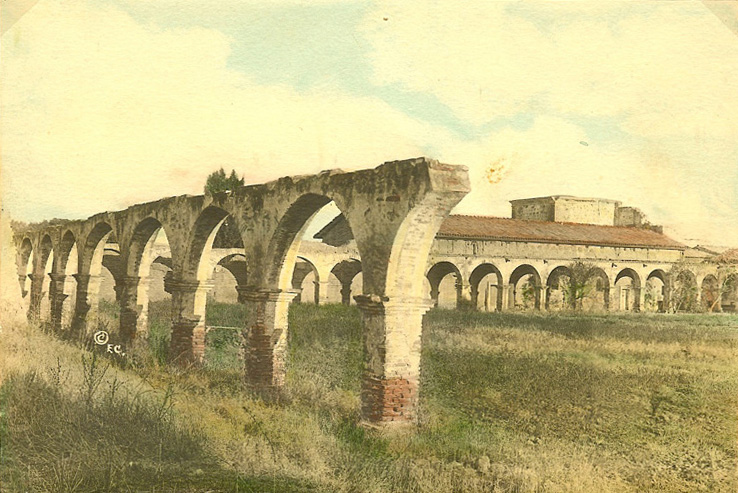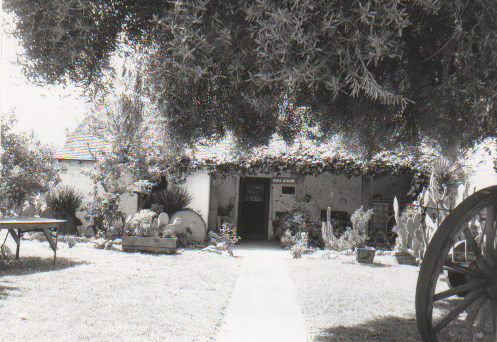This building dates back to sometime around 1794. In 2009 The Society bagan a restoration project. Jose Maria Silvas rebuilt it in 1868. In 1871, Silvas married Maria Manuela de Jesus Yorba, daughter of Domingo Yorba and Catalina Olivares. Click here for a full article on some of the history, and the restoration work done by the society.
Arley Leck House
The Historical Society raised funds to create the Richard Henry Dana statue in the Dana Point Harbor. With the help of the Mission Docents, funds were raised for the restoration of the Father Serra and Indian boy statue at Mission San Juan Capistrano. A bronze plaque in the Sacred Garden at the Mission was placed to honor Paul Arbiso, bell ringer of the mission for more than 60 years. Mr. Arbiso was also the Patriarch of the City of San Juan for 23 years.
The Society is presently raising funds to develop the Los Rios Historic Center, consisting of the O’Neill Museum, Leck House, Silvas Adobe and an old board and batten house on the property.
O’neill Museum
The Garcia/Pryor residence, now known as the O’Neill Museum, was built between 1870 and 1880 by Jose Garcia, a saloon owner, for his wife, Refugio Yorba. It was one of the first frame houses in San Juan Capistrano and was originally located on the lot directly behind the present El Adobe de Capistrano Restaurant. Unfortunately, Garcia was murdered in 1896 by a man known as Mestizo”, who was tried and convicted. He was sentenced to hang, but the sentence was reduced to life in prison. This sentence was also reduced and he was free in a few years. A story circulated in town that several prominent citizens wanted the land at Forster and Camino Capistrano streets on which Garcia’s saloon was located and had paid “Mestizo” to kill Garcia. Nothing was ever proven against any of the town’s citizens.
In 1903 Albert Pryor purchased the house from the Garcia family and he and his family lived there until 1955. Pryor spent many hours on the porch of the house, watching the children and the trains. He suffered a bad stroke in the middle fifties and the house was rented periodically. The “ghost” of Albert Pryor was supposed to sit on the porch occasionally and smoke a cigar. This usually frightened the tenants away.
Finally, in 1976, the Cornwell family, who owned the El Adobe Restaurant at that time, donated the building to the San Juan Capistrano Historical Society. The Society raised funds in order to move the house across the railroad tracks to a new location on Los Rios Street. The property was leased from the Oyharzabal family who has since donated the property to the Society. With lots of sweat, blisters, and aching joints the members of the Society restored the house and furnished it with period furniture. The cost was over $100,000. The O’Neill family donated $60,000 and the Society raised matching funds. The building became know as the O’Neill Museum in honor of Marguerite O’Neill, revered member of the O’Neill family who kept Rancho Mission Viejo from being sold.
The house was originally constructed as a four-room home with no bath or kitchen (most cooking was done outdoors). About 1895 a bathroom was created in the back bedroom, closets were made from space in the front bedroom and other alterations were made. In the 1920s the kitchen was added although it still did not include a stove.
Today the Museum also is the San Juan Capistrano Historical Society headquarters and the center of all its archives of photos, books, documents, maps, genealogical records, oral histories and much more.
The Sante Fe Railroad Depot 26701 Verdugo Street
The old Santa Fe Railroad Dept has long been an integral part of San Juan’s history and lore. It all began in 1887 when a railroad track was laid through town to connect Los Angeles and San Diego. First, a Nordic-style wood frame building was erected, and then replaced in 1894 by the present day Mission-style building. The new brick depot was at first only a small cube with a bell tower, telegraph office, waiting room, and storage room for freight. The roof tiles are believed to have come from the Mission ruins.
The Depot has been the scene of any number of events, some historic and some with a degree of levity. Memorable is when our town drunk fell asleep in the middle of the tracks and had a train ride over him. He never received a scratch but complained about being awakened when some friends ran from the Mexico Lindo Bar nearby to see if he was okay. Earlier in 1889, Modesta Avila strung her laundry across the tracks to protest the railroad’s existence and was sentenced to San Quentin for her misdeeds. Then there was the time when in evenings after the dispatcher left for home and someone wanted to board a train, they would put a washtub alongside the tracks and lit a fire to signal the train to stop.
In 1925 San Juan was the scene of the last great train robbery in Orange County. One evening as the train was traveling slowly through town; a robber jumped to the ladder on the side of a car, climbed on top, kicked through a side glass window, then shot down into the car and wounded the attendant. He lowered himself down a rope ladder, broke a mail car door window and reached through to un-latch the door and gain access. He rifled the mail pouches and strongbox then jumped off the train and presumably caught a southbound train. The wounded attendant later was found and rushed to the hospital, but passed away. It was discovered that only five dollars was taken from the strongbox but $2,100 was stolen from the mail sacks. Despite offers of rewards, the robber/killer was never apprehended.
Then there was an event of a different sort in the 1980s, when former Mayor Larry Bucheim and some friends dressed up as deputies with badges and side arms. They boarded the train in Santa Ana with two guys bound in handcuffs. The train conductor wanted to know what this was all about and Larry said they had just rounded up these two unseemly miscreants and had to take them to San Juan Capistrano to be tried in our local courthouse (which we didn’t have). The conductor had them ride in the back end of the train but this did not stop the passengers from going out of their way to see what was happening.
When the train stopped at our Depot, up rode a large group of cowboys with their guns prominently displayed. They boarded the train and forced “the deputies” out and made them lie down on the pavement. They took their guns and the two desperados and rode off quickly out of town. Pandemonium broke out with the passengers, train crew, and visitors around the depot. It took quite a while for Larry to explain that everything was all right and just San Juan’s way of celebrating the return of the Swallows to the Mission.
On September 25, 1942, during WWII, a special train arrived unannounced but soon it became apparent that President Franklin D. Roosevelt was on board. Earlier the town had been aroused when Marines arrived in trucks, surrounded the Depot, and some were even posted on top of nearby buildings with machine guns. A limousine picked up the President at the Depot; he was then driven to the Mission and paused by Father Arthur Hutchison to be blessed. Roosevelt then went on to Camp Pendleton for a visit.
Traveling by train ceased in the ‘50s and the Depot was boarded up from 1966 to 1974. Next came the restaurant period. Several came and went, but it wasn’t until the present operators moved their restaurant Sarducci’s to the Depot that a restaurant at this location became successful. Traveling by train started again when Amtrak and Metrolink began to provide service in the 1990’s.
The Egan House – Harmony Hall – 31892 Camino Capistrano
The Egan House, located across from El Adobe de Capistrano Restaurant, was constructed in 1883. After a fire in 1897 destroyed the upper part of the structure, it was rebuilt in 1898. The house is a Victorian/Greek Revival building. It was built of terra cotta brick brought from San Diego. The bricks were “left over” from a slight “miscalculation” on the part of Richard Egan when he was ordering the bricks for Casa Grande. Casa Grande was the former home of Marcos Forster family on El Camino Real and which torn down in 1965.
Judge Richard Egan was born in Ireland and settled in San Juan Capistrano in 1868. He purchased 160 acres at $1.25 an acre on the north end of town on Camino Capistrano. He later sold the land to R. Y. and W. B. Williams for $60,000. He first lived in an adobe on this ranch, but the adobe was later washed away in a flood.
Guests on Judge Egan’s porch.
Lady in middle, top row, is Madame Helena Modjeska, renowned Polish actress.
In 1883 Egan built this house and named it Harmony Hall. It was known for the social activities of Judge Egan which included balls, picnics, dinners and parties. The Judge was also a landowner, farmer, telegrapher, notary, surveyor, agent for nearby landowners, keeper of rainfall records, dispenser of charity to the needy, and a Justice of the Peace. From 1870 to1890 Judge Egan’s name did not need to be on the ballot for him to be re-elected.
Egan was also a Los Angeles County Supervisor from 1885 to 1889. When Orange County was formed, he was instrumental in defining the boundaries between the two counties. Judge Egan was also instrumental in securing rights of way for the Santa Fe Railroad in town.
When the house had a fire in 1897, much of Judge Egan’s historical collection of documents and artifacts was destroyed. When he passed away the remainder of his collection was taken by his heirs back east and since has been unable to locate their whereabouts. William English, a well-known contractor of the period built this Victorian/Greek Revival one and one-half story house. It has a shingled roof and dormer windows, four rooms downstairs and two rooms in the attic which were used for Egan’s elegant balls. In the basement was a wine cellar. The house still has the original mahogany floors.
Over the years the house has changed ownership many times and became at times an office, galleria, restaurant, boutique and now a restaurant once again.
EL ADOBE de CAPISTRANO – 31891 Camino Capistrano
First adobe on left eventually became the El Adobe restaurant, 2nd is the Domingo Yorba Adobe, 3rd is the Garcia Adobe French Hotel
The building that houses El Adobe de Capistrano restaurant today was originally two adobes. The northern section of the building was the home of Miguel Yorba. The southern section of the building was used as the Justice Court and Juzgado (jail). The building has been used as a post office, store, and stage depot. The home of Miguel Yorba may have been built by his father, Jose Antonio Yorba II, as he was living there in 1841.
The southern building has the more colorful history. It was not known when it was built but appears to have been erected early in the 1800s. It became the Justice Court in the upper part of the building and the jail was located in the cellar.
The Seeley & Wright Stage Line from Los Angeles to San Diego operated in the 1850s and stopped in San Juan Capistrano overnight. The driver drove the team through the opening between the two adobes and the passengers spent the night at a local hotel. Early the next morning they were again on their way.
Harry and Georgia Vander Leck joined the two adobes in 1910 and used them as their residence and store. By joining the two, the couple was able to create a dining room in the area between the two. Each end of the building had a wing that led to the rear and extended the building down to the west. The wings had lower floors than the main buildings. There was a frame addition on the west side which made the house quite large.
In 1946 Clarence Brown purchased the adobes and turned them into today’s El Adobe de Capistrano Restaurant. The restaurant opened on July 8, 1948 with a wedding reception for the first Commanding General of Camp Pendleton, General Joseph C. Fegan. President Richard Nixon was a frequent guest when he resided in San Clemente and enjoyed the Mexican cuisine.
The adobes have had several additions creating a place where many social events take place. A large area was added to the west side of the building featuring a ceiling that slides open to the sky. It was built by Roland Olsen. A chapel setting was created for weddings which are often held in the large western patio. The old Juzgado (jail) is now the wine cellar. Today the property is owned by Rancho Mission Viejo and the restaurant is leased to Melinda and Tony Moiso, Gilbert Aguirre and Steve Nordeck.
The Forster Mansion – 27182 Ortega Highway
The Frank A. Forster mansion was built in 1910 and is on the City’s Inventory of Historic and Cultural Landmarks. This mansion is located on the Ortega Highway between the Capistrano Inn and the shopping center to the east. A beautiful mansion that was restored to its old glory by famous interior designer Martha Gresham who once owned it. Later she sold the house and it’s being loving preserved by present owners internationally famous photographer Phillip Stewart Charis and his wife Maryanne .
Frank Forster was the grandson of Don Juan Forster who once owned the Mission and one of the largest ranches in California. Like most of Frank’s family, he was a successful rancher and lived in a small home on the site but decided to build a mansion for his family. He had Train & Williams, an architectural firm from Los Angeles, design a Mission Revival Style home. Its first floor is solid reinforced concrete with a large basement. The second floor is wood framed with plaster. The house was the first stucco covered home built in this area. This mansion has 6000 sq. ft. of living space which includes a large gracious living room that has a massive rock fireplace built from rocks that came from Salt Creek in South Laguna. Originally the house had gas lighting throughout. It also became the social hub of this area with extravagant BBQ’s and piano recitals. The total cost was only $10,000.
After Frank and his wife Ada passed away, the house was left to their son and three daughters. One daughter, Alice Forster Leck, lived there quite a while and left the house to her nephew Pancho Forster. The house began to decline and was sold to Bill Reid and Nario Iwata for $125,000 in 1975. By 1983 the house had deteriorated, but Martha Gresham came to the rescue, negotiated with Reid and bought it for $625,000. Ms Gresham restored the house to its original glory and it became a premier site to visit. Much later she sold the house to the Charis family who have faithfully retained its rich beauty. They lived in the house for a time, then created the House of Photographic Art. In the adjacent shopping center, they maintained their photography studio. This house is the last of the truly elegant homes built here just before and after 1900.
The Forster Mansion is also famous for one of the delightful legends that abound in our historic old village. It has a ghost! Billy Reid use to tell about the cigar smoking ghost who visited him. He believed it came from the old cemetery located across the street on the hill. He often smelled the cigar smoke and would hear doors opening and slamming upstairs. But Ms. Gresham told more expansive stories. She was a bit of a physic and said she had seen the ghost quite often and gave him the name of George. He was described as being short, stubby, had a moustache, and wore khaki clothing. He was always happy and friendly but smelled of cigars which she abhorred. She believed that he may have been one of the original builders. During the restoration work, contractors found a petrified cigar stub behind a plaster wall which Ms. Gresham kept.
Los Rios Historic District – Los Rios Street between Del Obispo and Mission Street
A glimpse of the past can be seen as one walks along Los Rios Historic District and the oldest residential street in California. This narrow street, without sidewalks, but with large mature trees, speaks of a time long past when individuals lived in small cozy houses, knew their neighbors, and were related to many who lived on the same street. Mothers and fathers, sons and daughters, aunts and uncles, grandparents, nieces and nephews, cousins, all grew up in the area and many still remain.
Los Rios Historic District is just that: an historic district. The street is on the National Register of Historic Places and includes those houses facing Los Rios Street. A street that has not changed all that much since it first became a location for the homes of the Acjachemen/Juaneno Indian neophytes who were not confined to the Mission. This in itself was unusual. At most Missions the neophytes lived in reed huts, “kichas”, which were burned when old and rebuilt as needed. Of the original adobes, all were built about 1794, once lined this street, only three left: the Silvas, Rios, and Montanez Adobes. The Rios Adobe has been continuously occupied by descendents of the original owner.
As the other adobes vanished due to neglect or demolition, board and batten houses of similar sizes and appearance replaced them. These houses are called “contributing structures” to the Historic District. Los Rios had always been a working class neighborhood which exhibits the changing tastes of over 200 years of building. The street made the National Register of Historic Places because it has a good collection of single-wall constructed dwellings, such as the Lupe Combs House, Pedro Labat House, Ramos House, and the Olivares House. Other historic houses have been moved into the District for preservation, the O’Neill Museum (Garcia/Pryor House), the Yorba/Love House, George “Buddy” Forster House, and the Arley Leck House.
The houses are set back from the street and are usually less than 1,000 square feet in size. The lush landscape and mature trees give a feeling of permanence.
Mission San Juan Capistrano – 31882 Camino Capistrano
Construction of Mission San Juan Capistano, “Jewel of the Missions”, began in November 1776. Father Junipero Serra named it for St. John of Capestrano in Italy, a warrior priest of the 15th century. This is the seventh in the chain of missions founded by Father Serra. The current location is the second site because of a lack of water at the first. It has been speculated that the first site may have been located near San Juan Creek in the area of the Lacouague Ranch or perhaps on Rancho Mission Viejo or even where the Vejar-Pryor/Hide House stands.
Father Ferman Francisco de Lausen and Father Gregorio Amurrio made a beginning on October 30, 1775, when friendly indigenous natives helped build the first structure. By November 6, 1775, however, news arrived that Indians had attacked San Diego. Lt. Jose Francisco de Ortega, who helped explore the area and selected the site, left for San Diego and urged the padres to leave as well. The mission bells were buried and everyone left. In September 1776, Father Amurrio returned to the Capistrano area with Father Pablo Mugartegui and ten soldiers. They found the cross still standing and uncovered the bells. On November 1, 1776, Father Serra personally and officially founded Mission San Juan Capistrano.
The mission was built as a vast quadrangle and was completely self-sufficient. It housed storage rooms for provisions, shops for making various needed materials, living and dining facilities for the priests and dormitories for the Acjachemen Indian neophytes (today known as Juanenos). A wing to the south of the quadrangle housed the soldiers, a jail and a powder magazine.
The entire mission is built of adobe bricks covered with a “stucco” of adobe mud. The roof is of fired clay tiles. It is not a perfect square as the priest paced off the measurements without using any surveyor’s instruments. Much of the demolished mission has been restored, but work continues on preserving what is left.
The mission thrived and in 1796, after granaries and homes for the neophytes (Juanenos) had been built, Fathers Vincente Fuster and Juan Norberto de Santiago began construction of the Great Stone Church. Isidro Aguilar, a half-Aztec stonemason from Culican, Mexico, was brought to California to supervise the construction of this massive church. Isidro guided the construction of the church until his death in 1803. The church was completed and dedicated September 7, 1806, with many prayers and feasting which went on for days.
The Great Stone Church stood only six years until December 8, 1812, when a tremendous earthquake shook most of Southern California from San Luis Obispo to Oceanside. The church bell tower fell into the church, carrying two young boys to their deaths. Mass had just started when the quake occurred and the parishioners panicked, trying to get out of the doors which had twisted in the quake and would not open. Those who followed the priests’ directions to go to the sacristy survived, others did not. When the shaking finally stopped, forty people had died. The church was in ruins and was never rebuilt.
In August 1834, the Mexican government confiscated the property of the mission and many Juanenos left San Juan Capistrano. In 1845, Governor Pio Pico sold the mission at auction to James McKinley, a merchant, and John Forster, Pico’s brother-in-law, for $710. Forster promptly moved his family into the mission (gift shop area) and James McKinley is never again mentioned in mission history.
Mission San Juan Capistrano steadily declined after the earthquake in 1812. It does not appear that Mr. Forster ever did much maintenance on the mission buildings. As one of his last acts before his assassination, President Abraham Lincoln signed the documents that returned the mission buildings to the Catholic Church in 1865. Forster moved his family to Rancho Santa Margarita y Las Flores, today Camp Pendleton.
Preservation of the mission was begun in 1895 when the Landmarks Club of Los Angeles, under the direction of President Charles F. Lummis, sought to preserve the missions of California. They came to San Juan and re-roofed many of the buildings of the quadrangle and repaved a mile of walkways with asphalt and gravel. The Landmarks Club put a new shake roof on the Soldiers Barracks and repaired holes in the walls. Feeling the mission buildings were now in more stable condition, the Club turned to another mission. Without their help, it is uncertain whether any of the buildings would have survived to further restoration by Father St. John O’Sullivan.
Father O’Sullivan had met Father Quetu, a resident of San Juan Capistrano, at a chance meeting in Arizona. O’Sullivan was suffering from tuberculosis and Father Quetu suggested he come to visit him. In 1910 Father O’Sullivan stepped off a train in town, walked a block to the corner of Verdugo and Camino Capistrano and saw the mission for the first time. He was struck by the magnificent ruin of the mission and decided to stay for the remainder of his life and restore it. He became the first resident priest since 1886.
Working with his own hands, carving window frames, making beams, and uncovering and storing items for later use, O’Sullivan restored the mission and his own health. Slowly others came to work with him and by the time of his death in 1933, the mission was in much better condition than it had been for decades. Restoration work continued on the Mission and people became more interested in the history of Mission San Juan Capistrano and the town.
During the1950s much was accomplished at the mission. Fund drives were undertaken for restoration. A school was opened on the mission grounds, a new parish hall and a gym were built. Sidewalks were installed and restoration was started on the ruined west wing. Corridor arches were rebuilt using original arches still standing as examples; beams of the mission were renovated and repaired. The Serra Chapel was repainted to its original splendor and the retablo (the ornate background of the altar) was redone with gold leaf.
One of the most ambitious projects of the 1980s was the construction of a new parish church located at the corner of Camino Capistrano and Acjachema Street. It was built along the lines of the Great Stone Church except it is 1/5th larger than the original. The church was designed by architect John Bartlett and interior design was researched by historian Norman Neuerberg, who personally painted many of the designs. The church was dedicated in 1987.
Also in1987 a stabilization program was inaugurated to ensure that the Great Stone Church continues to be a focal point of the mission. Nearly two centuries of deterioration had caused a great amount of damage. It was possibly the largest preservation project in California.
Today the mission buildings are used for various purposes. The north wing was formerly the convent for the teaching nuns and today is used for offices and other utilitarian purposes. The west wing was formerly shops for weaving, sewing and other chores and is now a museum. The adjacent iron smelter, wine and olive presses and the area for treating hides and making tallow are on display.
The east wing is where the Serra Chapel is located. The beautiful rare old retablo behind the altar, carved from cedar by skilled Spanish craftsman of more than 200 years ago. It had been sent in 1906 from Spain to the Archdiocese of Los Angeles where it was stored. In 1924 Father O’Sullivan had asked for permission to go to Mexico to find an appropriate altar for the Serra Chapel. Instead, the Bishop gave O’Sullivan permission to install this retablo in Father Serra’s old church. The retablo was so tall that the roof of the Chapel had to be raised. It is covered with gold leaf which is renewed periodically. The parish rectory is in this wing. Outside on the eastern side of the Chapel are the old mission Indian cemetery and the grave of Monsignor St. John O’Sullivan.
The south corridor contains historical depictions and displays. The soldiers’ barracks have been renovated and are used for art shows. The companario wall (bell wall) has a statue of Father Serra and a Juaneno Indian boy near the south side. On the north side is the Sacred Garden, a fountain, and commemorative plaque honoring Paul Arbiso. Paul was the Mission bell ringer for more than 60 years and the Patriarch of San Juan Capistrano for 23 years.
A new parish school with additional buildings for parish activities, such as conferences and parish offices has also been completed on the north side of the mission property.
In many ways the mission grounds are still the center of activities in the City of San Juan Capistrano. The central courtyard has become the setting for concerts, private events, garden, arts, and crafts shows. Something is always going on at the mission.
In the year 2000, Pope John Paul II decreed that Mission Church San Juan Capistrano, is to be honored with the title “Basilica”.
Rios Adobe – 31781 Los Rios Street
The Rios Adobe is the oldest continuously occupied residence in California and is located on Los Rios Street. Los Rios Street was named for this family. It has been occupied by the descendents of the original family for over 200 years. Feliciano Rios came to San Juan Capistrano with Father Junipero Serra in 1776. He served as a soldier at the Mission for at least ten years before his retirement. Rios married Maria Catalina Garcia de Romero of Mission San Gabriel in 1793 and was given permission by the Mission in 1794 to build a home. This was one of the twenty adobes built along Los Rios Street.
In 1843 Santiago Rios, third son of Feliciano was given a Mexican land grant of 7.7 acres within the original grant (300 varas square) on which the house still stands. He received this grant from Mexican Governor Manual Micheltorena. This is the smallest Mexican land grant recorded. Mexican land grants conveyed title to the land. During the 19th century the building passed down through the family to male descendents. These men and their wives are a significant part of the history of San Juan Capistrano.
Gregorio Rios, grandson of Santiago, is supposed to have sheltered the notorious bandito, Joaquin Murietta, in the attic of the house in the 1850s and may have provided horses as well. In the living room above a display case is a trap door that leads to an attic room where Murrieta was thought to have rested between raids on the ranchos.
A renowned horse trainer, Damian Cosmos Rios, son of Gregorio, often had individuals from England and the East Coast buying their polo ponies from him. In 1927 Gertrude Riena Rios, his wife, opened a restaurant, Casa de Los Rios, at the adobe. During the Depression period the restaurant provided additional income for the family which had nine children.
Daniel J. Rios, Damian and Gertrude’s son, landed on Normandy Beach in World War II. Daniel was later the head of the Homicide and Robbery details of the Orange County Sheriff’s Department. He was well-known for his barbecuing and salsa-making abilities. Many a barbecue was held at the Rios Adobe.
Juanita Rios Foy, sister of Daniel, was born in the Rios Adobe and was the Matriarch of the City from 1986 to 1991. She was active in the Juaneno Indian Council.
The current owner of the adobe is Stephen Rios. Stephen is a former Marine and was Executive Secretary to Governor E. G. Brown, Jr. He was a member of the Native American Heritage Commission and worked to ensure burial sites would not be excavated. He is raising the 10th generation in this adobe.
The Rios Adobe was originally two rooms much like the Montanez Adobe and has been added on and changed over the years, depending upon the generation that as living n the home at the time. In 1998 a two-story addition to the rear of the adobe was added but did not change the adobe itself.
The Rios Adobe is a Private residence. Please respect the families privacy and view from the street only.
